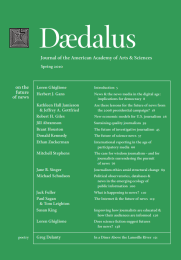Journalism ethics amid structural change
Journalism–as a practice, a product, and a profession–is undergoing rapid and dramatic structural change. There are four key aspects of this change, each with its own ethical implications.
- Economic structure is changing. For many practitioners, the collapse of previously reliable business models is the most pressing, and distressing, of the changes. Tactics to develop alternative revenue streams and to shore up old ones create new or newly intensified ethical pressure points.
- Organizational structure is changing. Newsrooms are being dramatically resized and reconfigured, and roles within them rethought. New responsibilities and working conditions generate ethical issues for journalists.
- Narrative structure is changing. As journalists have adapted to the Internet, their stories have taken on a more postmodern form. The construction of meaning is more fluid than in the past, and the process of that construction is more open and transparent. In addition, new formats have encouraged and facilitated a more personal narrative style. Traditional ethical guidelines for “making news” are being reconsidered.
- Relationship structure is changing. Relationships between journalists and “the people formerly known as the audience”1 are evolving to accommodate the increasingly open and fluid construction of meaning just described. Practitioners are revisiting ethical principles predicated on maintaining professional distance and difference.
These four aspects of occupational change are interconnected, and so are the ways in which they affect the ethical beliefs and behaviors of journalists. However, by first exploring each on its own, we can then attempt to weave the strands together and look to the future.
As the first decade of the twenty-first century ended, media organizations faced a double economic whammy. One aspect is cyclical. The widespread economic downturn has been very bad news for the industry. Among other effects, virtually none of them positive, stock prices have plummeted, advertising revenue has evaporated, and many readers have decided that the pennies spent on a newspaper are among the easiest to pinch. The combination means less–much less– money available to do journalism.
. . .
Endnotes
- 1Jay Rosen, “The People Formerly Known as the Audience,” PressThink, June 27, 2006, http://journalism.nyu.edu/pubzone/weblogs/pressthink/2006/06/27/ppl_frmr.html (accessed August 23, 2009).
